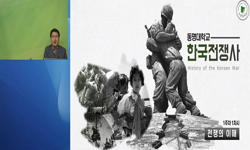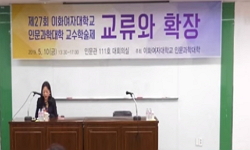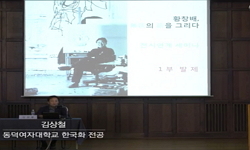한국의 두 번째 여성감독인 홍은원감독의 <여판사>필름 발굴(2015)과 최초의 여성감독인 박남옥감독의 작고(2017)로 초기 여성감독의 작품을 다시 읽는 작업이 갈급해졌다. 이 글은 영화의...
http://chineseinput.net/에서 pinyin(병음)방식으로 중국어를 변환할 수 있습니다.
변환된 중국어를 복사하여 사용하시면 됩니다.
- 中文 을 입력하시려면 zhongwen을 입력하시고 space를누르시면됩니다.
- 北京 을 입력하시려면 beijing을 입력하시고 space를 누르시면 됩니다.

전후영화에 나타난 여성 인물의 재현 = A Study on Representation of Woman Character(s) after the Korean War: from < The Widow > to < A Woman Judge >
한글로보기https://www.riss.kr/link?id=A103523619
- 저자
- 발행기관
- 학술지명
- 권호사항
-
발행연도
2017
-
작성언어
-
-
주제어
<미망인> ; <여판사> ; 전쟁미망인 ; 상호텍스트성 ; 한국전쟁 ; 공적 공간 ; 사적 공간 ; 위험한 여성 ; 시대정신 ; The Widow ; A Woman Judge ; war widow ; intertextuality ; the Korean War ; public sphere ; private sphere ; dangerous flesh ; zeitgeist(the spirit of the age)
-
KDC
377.605
-
등재정보
KCI등재
-
자료형태
학술저널
-
수록면
137-170(34쪽)
- 제공처
- 소장기관
-
0
상세조회 -
0
다운로드
부가정보
국문 초록 (Abstract)
한국의 두 번째 여성감독인 홍은원감독의 <여판사>필름 발굴(2015)과 최초의 여성감독인 박남옥감독의 작고(2017)로 초기 여성감독의 작품을 다시 읽는 작업이 갈급해졌다. 이 글은 영화의 마지막이 유실되고 사운드가 부분적으로 사라진 불완전한 텍스트인 영화들을 시나리오, 신문과 잡지기사, 감독의 글 등 다양한 자료에 기대어 그것들을 서로 맞추어가며 상호텍스트성을 경험하는 것을 목적으로 한다. 여성감독에 의한 영화이며 여성(관객)을 위한 영화인 <미망인>(1955)과 <여판사>(1962), 이 2편의 영화를 담론차원에서 접근하는 과정은 영화를 구성하는 여러 층위를 관통하고 한국전쟁 직후인 1950년대 중반에서 1960년대 초반에 이르는 시기의 시대정신과 영화의 의미를 이해하는 과정이 된다. 한국영화의 ‘새로운 르네상스의 시기’, 전후 여성인구의 증가와 여성의 경제적-사회적-법적 지위의 상승, 전후 ‘자유’와 ‘민주주의’ 수용과정에서의 여성에 대한 이중적 시선 등 이 지배적인 시기에 등장한 <미망인>과 <여판사>는 전후 폐허 속에서 재건이 요구되던 당시 여성들을 호명하는 영화였다. 영화 속에 재현된 여성 등장인물들은 전후 보호와 유혹의 대상인 위험한 여성들로 취급받은 전쟁미망인의 삶으로부터, 전통사회에 대한 비판의식으로 무장했지만 현실은 공적공간과 사적공간에서 우왕좌왕하는 여판사의 삶에 이르기까지 당시 근대의식을 가진 여성주체로서의 꿈과 짐에 대한 이야기임을 보여준다. 미망인 여성에게 던져진 욕망과 모성의 갈림길, 여판사가 가족과 직업에 동시에 대처하는 과정을 보여주는 이 영화들은 당시 다른 영화들과 차별화된 지점이면서 이 영화들 역시 당시 시대정신으로부터 자유롭지 않다는 것을 드러낸다. 이는 실제 벌어진 최초의 여판사의 죽음(1961)을 둘러싼 사회적 소란과 영화<여판사>의 유사성과 차이가 만드는 간극이며 <미망인>과 <여판사>가 서로 연결되며 채워가고 도달하는 어떤 지점이다. 당시 광고나 기사는 최초의 여성감독의 작업의 현실과 최초의 여판사를 연상하게 하는 영화속 등장인물과의 관계를 시종일관 상기시키기 때문이다.
다국어 초록 (Multilingual Abstract)
Recently, the death of the first ever woman director, Park Nam-ok( The Widow ), and the discovery of A Woman Judge , a film directed by Hong Eun-won, the second woman director from Korea, increased the need to reinterpret early woman directors’ work...
Recently, the death of the first ever woman director, Park Nam-ok( The Widow ), and the discovery of A Woman Judge , a film directed by Hong Eun-won, the second woman director from Korea, increased the need to reinterpret early woman directors’ work. This paper navigated the intertextuality from variety of materials -scenario, newspaper(s), magazine article(s), and excerpt from director(s) - since the texts of these movies were incomplete: lost ending and partially missing sound track. Observing The Widow (1955) and A Woman Judge (1962), the films made by and talked about women, from discoursive point of view (speared the multi-layers of movie and it) leads to understand the spirit of the period and the meaning of movies right after the Korean War: from mid-1950s to early 1960s. After the war, the increase of female population, the rise of women’s economical-social-legal status, and the dual viewpoint about women while accepting the freedom and the democracy were dominant. The Widow and A Woman Judge appeared during this ‘New Renaissance of Korean Film’ (and called out to women who needed to reconstruct from ruins). From the war widow, treated as a dangerous flesh, an object of post-war protection and seduction, to the woman judge, armed with criticism against the traditional society, and yet in real life, swayed between the public sphere and the private one, the (main) female characters represented the dream and burden of modern consciousness as a female subject in those days. These movies presented the crossroads between desire and motherhood (for The Widow) and the coping process between family and work (for A Woman Judge) to differentiate from the others around the same time period and also to show that even these could not get away from the spirit of the age. It was a gap generated from similarities and differences between A Woman Judge and the social turmoil around the death of the first female judge in 1961; and it was a point where The Widow and A Woman Judge should reach as they tangled and supplemented each other. Advertisements and newspaper articles during that time constantly reminded audience the correlation between the reality of the first woman director’s work in women discourse and the character in the movie who brought up the image of the first female judge.
목차 (Table of Contents)
- I. 들어가며
- II. <미망인>, 50년대 미망인 재현의 원형
- III. <여판사>, 최초의 여판사, 꿈과 짐
- IV. 나가며
- I. 들어가며
- II. <미망인>, 50년대 미망인 재현의 원형
- III. <여판사>, 최초의 여판사, 꿈과 짐
- IV. 나가며
동일학술지(권/호) 다른 논문
-
리앙 문학에 나타난 정치 폭력 속 약소자의 모습과 저항 방식 : 『北港香爐人人插를 중심으로
- 순천향대학교 인문과학연구소
- 신춘란(Shen, Chun Lan)
- 2017
- KCI등재
-
- 순천향대학교 인문학연구소
- 허윤진(Hur, Yoonjin)
- 2017
- KCI등재
-
- 순천향대학교 인문학연구소
- 손광민(Son, Kwang-Min)
- 2017
- KCI등재
-
영유아기 자녀를 가진 취업모의 양육 스트레스 종단적 궤적과 설명 변인
- 순천향대학교 인문학연구소
- 이희정(Lee, Hee-jung)
- 2017
- KCI등재





 RISS
RISS 스콜라
스콜라







